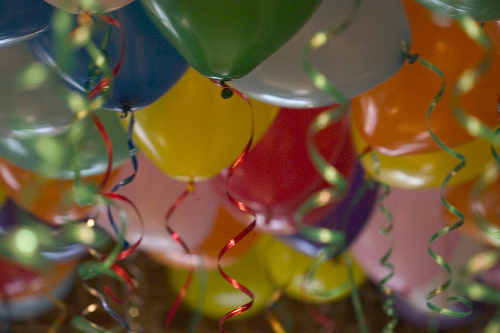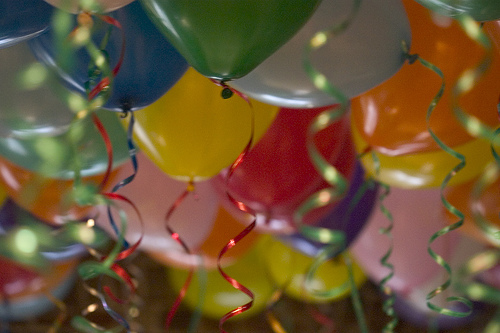Send your question to Umbra!
Q. Dear Umbra,
Are there any toxic chemicals in balloons? How about endocrine disruptors like BPA? This is a product that both kids and adults alike are exposed to when blowing them up. Please let me know what you find out.
Heather R.
 Cause for celebration?Photo: Nicole HanusekA. Dearest Heather,
Cause for celebration?Photo: Nicole HanusekA. Dearest Heather,
While I have, believe it or not, written about hot air balloons before, I haven’t tackled their smaller, less-suitable-for-travel sister, the party balloon. It would probably do us all well to think more carefully about more things that we press our lips to, from produce to party favors.
Let’s whiz through the basics of balloon production. (We can skip over the part where, back in the day, balloons were made from animal bladders.) Para rubber trees (originally in South America) produce a white, sticky sap — latex — that may be turned into rubber for our party balloons. Latex’s poser friend, polyisoprene, is paradoxically referred to as a synthetic natural rubber. Like so many shiny, stretchy things, it’s a petroleum product. The synthetic/natural split of rubber today is approximately 60/40, with the 40ish percent mostly coming from Thailand, Indonesia, and Malaysia.
You can guess where I’m going with this, right? Even before addressing toxicity, we’re faced with yet another product furthering our dependence on oil, or traveling halfway around the world to get to our surprise party. But perhaps I overreact. Polyisoprene is also used in latex-free condoms, and no one is arguing we should stop wearing those. (Relatedly, perhaps you can simply blow up some expired condoms the next time you have an adult celebration.)
Are latex balloons toxic? It’s surprisingly difficult to say. Renee Rottner briefly explains the mysterious ingredients that go into balloons in addition to latex:
Certain chemicals are mixed in to achieve a desired thickness, rate of drying, and other properties. Other chemicals (collectively known as antidegradants) are added to slow the oxidation and decomposition of the rubber. To give it color, pigments are mixed into the latex. The pigments may be fine metal oxide powders or organic dyes.
Zinc oxide and iron oxide are two metal oxides commonly used as colorants. My best friend, the Cosmetic Safety Database, rates zinc and iron oxide both as low risk. You wouldn’t want to eat them, of course, but from what I can tell, there actually seems to be little reason to be alarmed about balloons (other than how tricky it is to find out exactly what’s in them).
However, I’d be remiss if I didn’t mention that latex doesn’t biodegrade quickly (despite those who may tell you not to worry about shards of popped balloons falling onto the ground), and as it breaks down even more slowly in water, people are concerned about the health risks to sea life that may munch on balloon remnants, thinking them a tasty snack. “Balloon litter floating at sea can be deadly for many animals,” says the Sea Turtle Foundation. “Sea turtles are particularly at risk as they mistake deflated balloons for their jellyfish food. Swallowed balloons block their gut and lead to death by starvation. Entanglement and subsequent drowning for baby turtles is an added risk.” Hurting baby sea turtles?! And here you just wanted something to match the streamers …
Shiny Mylar balloons are even worse, as they don’t break down.
The long and the short of it is that even something as airy and jovial as our color-coordinated party decorations has to come from somewhere, slurps up resources in its production and distribution, and then lingers somewhere else on the planet for who knows how long. It’s a little depressing, so try not to think about it for too long. Have a slice of cake, and a happy whatever-it-is-you’re-celebrating.
Elastically,
Umbra



